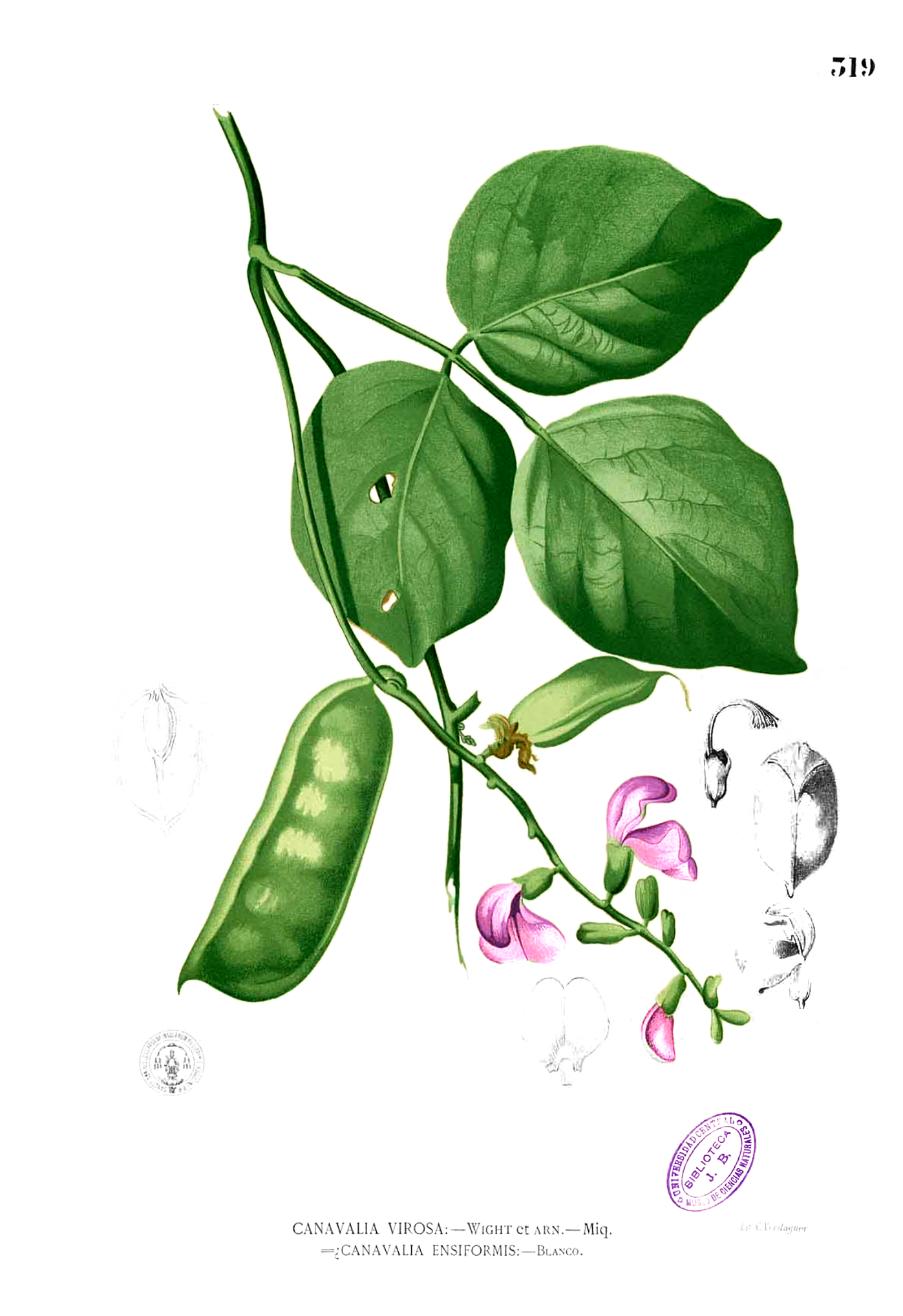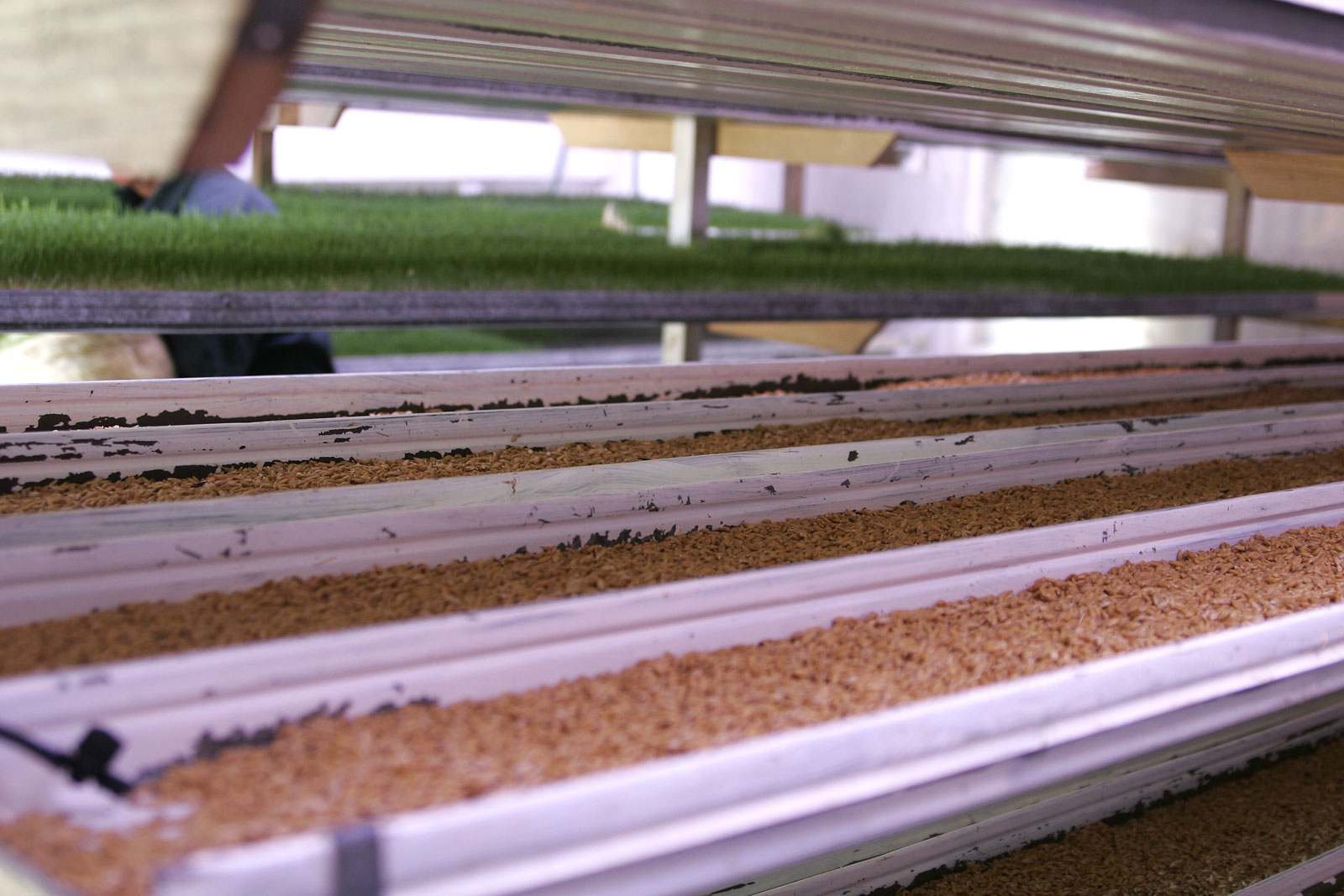|
Canavalia Ensiformis
''Canavalia ensiformis'' (jack bean) is a legume which is used for animal fodder and human nutrition, especially in Brazil where it is called ''feijão-de-porco'' ("pig bean"). It is also the source of concanavalin A. Description ''C. ensiformis'' is a twining plant up to in height. It has deep roots, which makes it drought resistant. The plant can spread via long runners. The flowers are pink-purple in colour. The pods are up to long with large white seeds. Uses Historically, it was used by native tribes for food and forage in droughty regions of Arizona and Mexico. Now, while commonly consumed in Asia and Japan, C. ensiformis seem to be unpopular elsewhere. The beans are mildly toxic, and copious consumption should be avoided. Boiling will, however, remove toxicity if done properly. Young foliage is also edible. The whole plant is used for fodder, although it cannot be used in fodder mixtures containing urea, since it contains large quantities of the enzyme urease, ... [...More Info...] [...Related Items...] OR: [Wikipedia] [Google] [Baidu] |
Canavalia
''Canavalia'' is a genus of plants in the legume family (Fabaceae) that comprises approximately 62 species of tropical vines. Members of the genus are commonly known as jack-beans. It has a pantropical distribution. The species of ''Canavalia'' endemic to the Hawaiian Islands were named ''āwikiwiki'' by the Native Hawaiians. The name translates to "the very quick one" and comes from the Hawaiian word for "fast". The genus name is derived from the Malabar word for the species, ''kavavali'', which means "forest climber." Uses Several species are valued legume crops, including common jack-bean ('' C. ensiformis''), sword bean ('' C. gladiata'') and '' C. cathartica''. At least the first makes a beneficial weed- and pathogen-suppressing living mulch. The common jack-bean is also a source of the lectin concanavalin A, which is used as a reagent in glycoprotein biochemistry and immunology. The jack-bean is also a common source of purified urease enzyme used in scientific research. ... [...More Info...] [...Related Items...] OR: [Wikipedia] [Google] [Baidu] |
Biotechnology
Biotechnology is a multidisciplinary field that involves the integration of natural sciences and Engineering Science, engineering sciences in order to achieve the application of organisms and parts thereof for products and services. Specialists in the field are known as biotechnologists. The term ''biotechnology'' was first used by Károly Ereky in 1919 to refer to the production of products from raw materials with the aid of living organisms. The core principle of biotechnology involves harnessing biological systems and organisms, such as bacteria, yeast, and plants, to perform specific tasks or produce valuable substances. Biotechnology had a significant impact on many areas of society, from medicine to agriculture to environmental science. One of the key techniques used in biotechnology is genetic engineering, which allows scientists to modify the genetic makeup of organisms to achieve desired outcomes. This can involve inserting genes from one organism into another, and con ... [...More Info...] [...Related Items...] OR: [Wikipedia] [Google] [Baidu] |
Fodder
Fodder (), also called provender (), is any agriculture, agricultural foodstuff used specifically to feed domesticated livestock, such as cattle, domestic rabbit, rabbits, sheep, horses, chickens and pigs. "Fodder" refers particularly to food given to the animals (including plants cut and carried to them), rather than that which they forage for themselves (called forage). Fodder includes hay, straw, silage, compressed and Compound feed, pelleted feeds, oils and mixed rations, and sprouting, sprouted grains and legumes (such as bean sprouts, fresh malt, or brewing#Brewer's spent grain, spent malt). Most animal feed is from plants, but some manufacturers add ingredients to processed feeds that are of animal origin. The worldwide animal feed trade produced 1.245 billion tons of compound feed in 2022 according to an estimate by the International Feed Industry Federation, with an annual growth rate of about 2%. The use of agricultural land to grow feed rather than human food can be ... [...More Info...] [...Related Items...] OR: [Wikipedia] [Google] [Baidu] |
Flora Of Brazil
The wildlife of Brazil comprises all naturally occurring animals, plants, and fungus, fungi in the South American country. Home to 60% of the Amazon Rainforest, which accounts for approximately one-tenth of all species in the world, Brazil is considered to have the greatest biodiversity of any country on the planet. It has the most known species of plants (60,000), freshwater fish (3,000), Amphibian, amphibians (1,188), Snake, snakes (430), Insect, insects (90,000) and mammals (775). It also ranks third on the list of countries with the most bird species (1,971) and the third with the most reptile species (848). The number of fungal species is unknown (+3,300 species).Da Silva, M. and D.W. Minter. 1995. ''Fungi from Brazil recorded by Batista and Co-workers''. Mycological Papers 169. CABI, Wallingford, UK. 585 pp. Approximately two-thirds of all species worldwide are found in tropical areas, often coinciding with developing cou ... [...More Info...] [...Related Items...] OR: [Wikipedia] [Google] [Baidu] |
Flora Of Africa
Flora (: floras or florae) is all the plant life present in a particular region or time, generally the naturally occurring ( indigenous) native plants. The corresponding term for animals is ''fauna'', and for fungi, it is '' funga''. Sometimes bacteria and fungi are also referred to as flora as in the terms ''gut flora'' or ''skin flora'' for purposes of specificity. Etymology The word "flora" comes from the Latin name of Flora, the goddess of plants, flowers, and fertility in Roman mythology. The technical term "flora" is then derived from a metonymy of this goddess at the end of the sixteenth century. It was first used in poetry to denote the natural vegetation of an area, but soon also assumed the meaning of a work cataloguing such vegetation. Moreover, "Flora" was used to refer to the flowers of an artificial garden in the seventeenth century. The distinction between vegetation (the general appearance of a community) and flora (the taxonomic composition of a community) wa ... [...More Info...] [...Related Items...] OR: [Wikipedia] [Google] [Baidu] |
Canavalia Gladiata
''Canavalia gladiata'', the sword bean or scimitar bean, is a domesticated plant species in the legume family Fabaceae. It is used as a vegetable in interior central and south central India, though not commercially farmed. The unripe pods are also eaten as a vegetable in Africa and Asia. The term "sword bean" is also used for other legumes, notably the common jack bean '' Canavalia ensiformis''. Description Appearance and Leaves Sword beans are a climbing, herbaceous vine that can reach lengths of up to 10 meters under optimal conditions. Inflorescence and Flowers The inflorescence is a raceme bearing 10 to 20 flowers, which are either white or light purple. Each flower measures approximately 3 cm in length. Fruits and Seeds The fruits are shaped as long, straight, slightly compressed pods, measuring 20-40 (up to 60) cm with a rough surface. Each pod contains 8 to 16 seeds, which are oblong-ellipsoid, variable in color, ranging from red and red-brown to white or bl ... [...More Info...] [...Related Items...] OR: [Wikipedia] [Google] [Baidu] |
Vicia Faba
''Vicia faba'', commonly known as the broad bean, fava bean, or faba bean, is a species of vetch, a flowering plant in the pea and bean family Fabaceae. It is widely cultivated as a crop for human consumption, and also as a cover crop. Varieties with smaller, harder seeds that are fed to horses or other animals are called field bean, tic bean or tick bean. This legume is commonly consumed in many national and regional cuisines. Some people suffer from favism, a hemolytic response to the consumption of broad beans, a condition linked to a metabolic disorder known as G6PDD. Otherwise the beans, with the outer seed coat removed, can be eaten raw or cooked. With young seed pods, the outer seed coat can be eaten, and in very young pods, the entire seed pod can be eaten. Description ''Vicia faba'' is a stiffly erect, annual plant tall, with two to four stems that are square in cross-section. The leaves are long, pinnate with 2–7 leaflets, and glaucous (grey-green). ... [...More Info...] [...Related Items...] OR: [Wikipedia] [Google] [Baidu] |
Lima Bean
A lima bean (''Phaseolus lunatus''), also commonly known as butter bean, sieva bean, double bean or Madagascar bean, is a legume grown for its edible seeds or beans. Origin and uses ''Phaseolus lunatus'' is found in Meso- and South America. Two gene pools of cultivated lima beans point to independent domestication events. The Mesoamerican lima bean is distributed in neotropical lowlands, while the other is found in the western Andes. They were discovered in Peru and may have been the first plant that was brought up under civilization by the native farmers. The Andean domestication took place around 2000 BC and produced a large-seeded variety (lima type), while the second, taking place in Mesoamerica around 800 AD, produced a small-seeded variety (Sieva type). By around 1300, cultivation had spread north of the Rio Grande, and, in the 1500s, the plant began to be cultivated in the Old World. The small-seeded (Sieva) type is found distributed from Mexico to Argentina, generally ... [...More Info...] [...Related Items...] OR: [Wikipedia] [Google] [Baidu] |
Broad Bean
''Vicia faba'', commonly known as the broad bean, fava bean, or faba bean, is a species of vetch, a flowering plant in the pea and bean family Fabaceae. It is widely cultivated as a crop for human consumption, and also as a cover crop. Varieties with smaller, harder seeds that are fed to horses or other animals are called field bean, tic bean or tick bean. This legume is commonly consumed in many national and regional cuisines. Some people suffer from favism, a hemolytic response to the consumption of broad beans, a condition linked to a metabolic disorder known as G6PDD. Otherwise the beans, with the outer seed coat removed, can be eaten raw or cooked. With young seed pods, the outer seed coat can be eaten, and in very young pods, the entire seed pod can be eaten. Description ''Vicia faba'' is a stiffly erect, annual plant tall, with two to four stems that are square in cross-section. The leaves are long, pinnate with 2–7 leaflets, and glaucous (grey-green). Un ... [...More Info...] [...Related Items...] OR: [Wikipedia] [Google] [Baidu] |
English Language
English is a West Germanic language that developed in early medieval England and has since become a English as a lingua franca, global lingua franca. The namesake of the language is the Angles (tribe), Angles, one of the Germanic peoples that Anglo-Saxon settlement of Britain, migrated to Britain after its End of Roman rule in Britain, Roman occupiers left. English is the list of languages by total number of speakers, most spoken language in the world, primarily due to the global influences of the former British Empire (succeeded by the Commonwealth of Nations) and the United States. English is the list of languages by number of native speakers, third-most spoken native language, after Mandarin Chinese and Spanish language, Spanish; it is also the most widely learned second language in the world, with more second-language speakers than native speakers. English is either the official language or one of the official languages in list of countries and territories where English ... [...More Info...] [...Related Items...] OR: [Wikipedia] [Google] [Baidu] |
Lectin Affinity Chromatography
Affinity chromatography is a method of separating a biomolecule from a mixture, based on a highly specific macromolecular binding interaction between the biomolecule and another substance. The specific type of binding interaction depends on the biomolecule of interest; antigen and antibody, enzyme and substrate, receptor and ligand, or protein and nucleic acid binding interactions are frequently exploited for isolation of various biomolecules. Affinity chromatography is useful for its high selectivity and resolution of separation, compared to other chromatographic methods. Principle Affinity chromatography has the advantage of specific binding interactions between the analyte of interest (normally dissolved in the mobile phase), and a binding partner or ligand (immobilized on the stationary phase). In a typical affinity chromatography experiment, the ligand is attached to a solid, insoluble matrix—usually a polymer such as agarose or polyacrylamide—chemically modified to ... [...More Info...] [...Related Items...] OR: [Wikipedia] [Google] [Baidu] |








